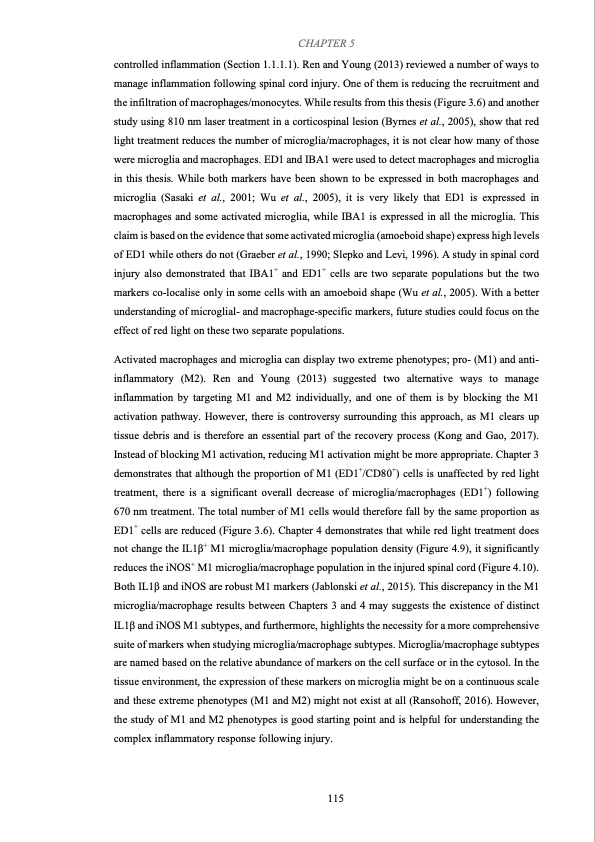
PDF Publication Title:
Text from PDF Page: 129
CHAPTER 5 controlled inflammation (Section 1.1.1.1). Ren and Young (2013) reviewed a number of ways to manage inflammation following spinal cord injury. One of them is reducing the recruitment and the infiltration of macrophages/monocytes. While results from this thesis (Figure 3.6) and another study using 810 nm laser treatment in a corticospinal lesion (Byrnes et al., 2005), show that red light treatment reduces the number of microglia/macrophages, it is not clear how many of those were microglia and macrophages. ED1 and IBA1 were used to detect macrophages and microglia in this thesis. While both markers have been shown to be expressed in both macrophages and microglia (Sasaki et al., 2001; Wu et al., 2005), it is very likely that ED1 is expressed in macrophages and some activated microglia, while IBA1 is expressed in all the microglia. This claim is based on the evidence that some activated microglia (amoeboid shape) express high levels of ED1 while others do not (Graeber et al., 1990; Slepko and Levi, 1996). A study in spinal cord injury also demonstrated that IBA1+ and ED1+ cells are two separate populations but the two markers co-localise only in some cells with an amoeboid shape (Wu et al., 2005). With a better understanding of microglial- and macrophage-specific markers, future studies could focus on the effect of red light on these two separate populations. Activated macrophages and microglia can display two extreme phenotypes; pro- (M1) and anti- inflammatory (M2). Ren and Young (2013) suggested two alternative ways to manage inflammation by targeting M1 and M2 individually, and one of them is by blocking the M1 activation pathway. However, there is controversy surrounding this approach, as M1 clears up tissue debris and is therefore an essential part of the recovery process (Kong and Gao, 2017). Instead of blocking M1 activation, reducing M1 activation might be more appropriate. Chapter 3 demonstrates that although the proportion of M1 (ED1+/CD80+) cells is unaffected by red light treatment, there is a significant overall decrease of microglia/macrophages (ED1+) following 670 nm treatment. The total number of M1 cells would therefore fall by the same proportion as ED1+ cells are reduced (Figure 3.6). Chapter 4 demonstrates that while red light treatment does not change the IL1β+ M1 microglia/macrophage population density (Figure 4.9), it significantly reduces the iNOS+ M1 microglia/macrophage population in the injured spinal cord (Figure 4.10). Both IL1β and iNOS are robust M1 markers (Jablonski et al., 2015). This discrepancy in the M1 microglia/macrophage results between Chapters 3 and 4 may suggests the existence of distinct IL1β and iNOS M1 subtypes, and furthermore, highlights the necessity for a more comprehensive suite of markers when studying microglia/macrophage subtypes. Microglia/macrophage subtypes are named based on the relative abundance of markers on the cell surface or in the cytosol. In the tissue environment, the expression of these markers on microglia might be on a continuous scale and these extreme phenotypes (M1 and M2) might not exist at all (Ransohoff, 2016). However, the study of M1 and M2 phenotypes is good starting point and is helpful for understanding the complex inflammatory response following injury. 115PDF Image | Effects of Red Light Treatment on Spinal Cord Injury

PDF Search Title:
Effects of Red Light Treatment on Spinal Cord InjuryOriginal File Name Searched:
Thesis_Di Hu_final.pdfDIY PDF Search: Google It | Yahoo | Bing
Cruise Ship Reviews | Luxury Resort | Jet | Yacht | and Travel Tech More Info
Cruising Review Topics and Articles More Info
Software based on Filemaker for the travel industry More Info
The Burgenstock Resort: Reviews on CruisingReview website... More Info
Resort Reviews: World Class resorts... More Info
The Riffelalp Resort: Reviews on CruisingReview website... More Info
| CONTACT TEL: 608-238-6001 Email: greg@cruisingreview.com | RSS | AMP |